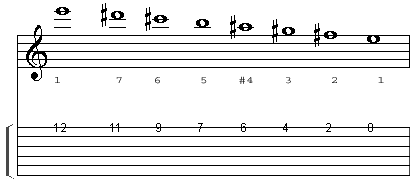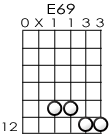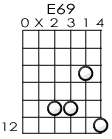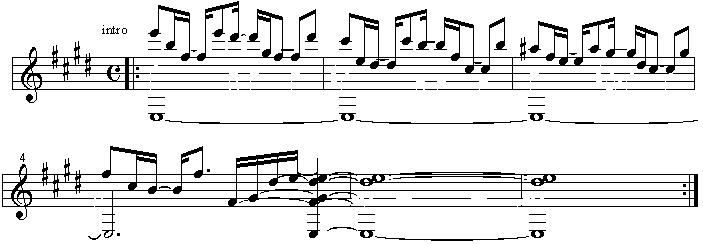When I was in music school my teacher gave me this homework assignment: He wanted me to take a scale and make seven chord voicings using all seven scale notes separately as the top note in each individual chord. I know, your confused, I just read the last sentence and I'm confused too. I'll explain a little more. Let's take a lydian scale, a descending E lydian scale to be exact. The first chord we construct from the scale will have as the top note the root, in this case an E note on the 12th fret of the first string. The next chord's top note will be the 7th (a D# note) on the 11th fret. After that, the top note on the first string will become the 6th (C#) on the 9th fret and so on until we get back to the root. Other than the top note in each individual chord and the root (E) on the bottom, all the other notes in each chord can be anything that pleases your ear as long as they can be found in the E lydian scale. This exercise was designed to help you learn how to construct your own chord voicings and at the same time increase your chord vocabulary.
Take a look at and play the descending E lydian scale below. We are going to find a chord voicing for every note in the descending scale. Why the lydian scale rather than the major scale you ask? Because the lydian scale is just plain better than the major scale for building major chords. The problem with the major scale is that the natural 4th and major 3rd rub against each other and bug the listener's ears when they both get included in the same chord voicing. For this reason, when you make chord voicings from the major scale you always have to be careful of combining the 3rd and 4th (although it is technically against the rules, it can be done by placing the 3rd way above the 4th in the chord voicing). With the lydian scale you don't have to worry about any of that. The raised 11th gets along fine with the 3rd and any other note in the scale for that matter.

Let's build the first chord. We already know what the top note will be for this chord (the 12th fret E note on the first string). We also know what the bottom note will be (since we are in E, we can just use the open 6th string. Only this note on the sixth string will stay constant throughout the whole process). What we haven't decided are the notes in between the first and the sixth string. You'll need to use a combination of your theory knowledge and your ear to work this one out. Technically any note in the E lydian scale will work OK. Since the top note on the E string has already been decided, all you have to work on are the notes on the 4th, 3rd and 2nd strings (let's leave out the fifth string). Try some different notes at random and let your ears decide which combination is best. Remember, the root as the top voice on the first string has already been predetermined so you should choose from any of the other notes (3, 5, 7, 9, #11, 13). If you need to, use the chart below as a reference.
| note | E | F# | G# | A# | B | C# | D# |
| chord/scale tone |
1 |
2 (9) |
3 |
#4 (#11) |
5 |
6 (13) |
7 |
Here are a few examples of some voicings you could make:
1. A super simple E69 chord. Nothing fancy here, just the standard voicing with the root up on top.

2. Another E69 chord. This one like the last one is still sticking to our rule of keeping the root as its top voice but unlike the previous example, the 5th has been replaced with the 3rd on the second string. Not a typical 69 voicing.

3. The only thing this voicing has in common with the first example is the root on the first string and the 9th on the third string. The raised 11th gives this chord a slightly more complex sound.

4. The most complex sounding of all the examples, this one has nothing in common with the first voicing other than the root on top.

After we determine which voicing we like the best as our first chord, we can go on and work on our next E major voicing which will have to have the 7th on the 11th fret of the first string as its top voice. The process continues until we have a voicing for each scale tone in the descending scale.
I came up with these chord voicings below. Some things to take notice of:
Little did I know that ten years later I would use this exercise to make a song that would be the title cut on my very first solo CD. Click here to hear it.

Try this exercise using some other scales and see what kind of voicings you can come up with.
New Yorker Chris Juergensen is long time studio musician and session guitarist currently living and teaching in Japan.
His latest project is "Big Bad Sun", a CD traditional in nature, and contemporary in sound.